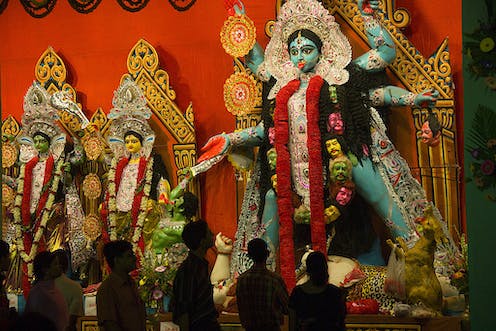People admire a massive statue of the Hindu goddess Kali. Jerry Redfern/LightRocket via Getty Images
As we approach Mother’s Day, many groups will hold special events or services to celebrate the holiday. In the United States, Mother’s Day was originally founded in 1908 at Andrews Methodist Episcopal Church in West Virginia and became a nationally recognized holiday in 1914. The mid-May date spread around the world, though many countries still maintain their own dates and traditions.
Religions around the world use these days to honor the importance of many kinds of nurturing, from traditional celebrations to events that honor modern parenting, infertility struggles or the pain of losing a child
Motherhood and nurturing are not celebrated only on particular days, however. Many religions include goddess-centered traditions that embrace many forms of the divine feminine as central to their belief systems.
As a religious studies professor who travels with students around the world to explore different cultures and practices, I have often noticed the interest students have in the variety of goddess traditions we encounter.
Asian traditions
Guan Yin, who goes by many variations of her name, is revered as the goddess of compassion and mercy in several different Eastern traditions. Beginning – interestingly enough – as a male bodhisattva called Avalokiteshvara, the goddess figure was adapted in many different cultures around the world. Called Kannon in Japan and Quan Am in Vietnam, she is frequently a focal point of temple worship and is also considered the guardian of sailors and a goddess of fertility.
An aerial view of a 3D rice field painting of Guan Yin at an agriculture industrial park in 2021 in Shenyang, China.
Zhang Wenkui/VCG via Getty Images
One of the most well-known goddesses in Hinduism, meanwhile, is perhaps the least understood from an outside perspective. Kali is often seen as a terrifying figure, depicted using multiple weapons and dressed in clothing of severed heads and arms. Yet Kali is also an important mother figure who channels her ferocity into the care and defense of all creation. As a manifestation of the primal force of Shakti, Kali is essentially all aspects of motherhood wrapped up into one, often simultaneously caring, loving and fierce.
The triple goddess
In Neopaganism, an umbrella term for a diverse group of new religious movements most popular in the United States, Australia and Europe, goddess figures also often play a primary role. Neopaganism’s various branches include Wicca and Hellenic reconstructionism, a religion that focuses on the gods and goddesses of Ancient Greece.
Of primary importance for many Neopagans is the triple goddess, a figure who encompasses the three aspects of maiden, mother and crone. Sometimes these goddess figures are based on specific ancient deities, such as Persephone, Demeter and Hekate, and sometimes they are worshipped more generally as representations of various phases of life.
More recently, many of these traditions are intentionally expanding to reject ideas of gender essentialism and embrace a range of identities. For some Neopagans, exploring what femininity and masculinity signify in today’s society is an important extension of religious belief and a way to include people who have felt rejected from other religious communities.
A Wiccan high priestess blesses another priestess during a seasonal sabbat in honor of Brigid, a Celtic goddess, in 2020 in Rio de Janeiro.
Andre Coelho/Getty Images
Beyond the goddess
Many other religions revere mother figures, even if they are not worshipped or considered goddesses. Khadija, the wife of the Prophet Muhammad and the first convert to Islam, is given the title “the Mother of Believers,” signifying her importance for the development of the religion. Devotion to Mary, mother of Jesus, has been common throughout the history of Christianity and remains popular today. In Judaism, the idea of “Shekinah” has been influential in some feminist thought. Rather than representing a single woman or female figure, Shekinah is seen as the feminine aspect of the divine, a manifestation of God’s wisdom on Earth.
Nurturing and compassion are key concepts in a variety of religions, whether they are represented as specific goddess figures, archetypes of the feminine or new religious developments that embrace shifting ideas about gender.
Alyssa Beall ne travaille pas, ne conseille pas, ne possède pas de parts, ne reçoit pas de fonds d’une organisation qui pourrait tirer profit de cet article, et n’a déclaré aucune autre affiliation que son organisme de recherche.













